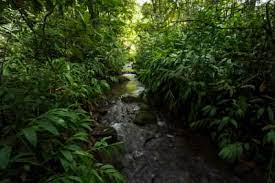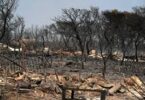SAN JOSE, Costa Rica (AP): Costa Rica went from having one of the world’s highest deforestation rates in the 1980s to a nation centered on ecotourism, luring world travelers with the possibility of moving between marine reserves and cloud forest in a single day.
But the Central American country known for lush jungle and rich biodiversity now faces a dilemma as one environmental priority – reforestation — runs headlong into another — reducing the use of fossil fuels.
The program that has paid landowners for 25 years not to cut down trees depends almost entirely on fuel tax revenue, which stands to fade away by 2050 as Costa Rica converts public and private transportation to electricity in pursuit of net-zero emissions. That has the government hunting for alternative funding options.
Those could include new taxes or a tweaked mix of existing ones. Tourists who flock to see toucans, sloths and brilliantly colored frogs might someday see a charge on their hotel bill to aid forest conservation. And Costa Rica will continue to pressure developed countries — the planet’s biggest polluters — to compensate countries doing more than their share to store carbon.
Costa Rica reforestation got a boost last year with President Rodrigo Chaves’ announcement of $16.4 million from the World Bank for forests that are reducing carbon emissions. The program will bring in a total of $60 million by the end of 2025, money Costa Rica hopes can double the amount of protected forest.
The money is one step toward the international community doing its part to preserve valuable forest, said Jorge Mario Rodríguez Zúñiga, director of the National Forestry Financing Fund, known by its Spanish initials FONAFIFO.
“If it benefits the world, it’s only fair that the world contributes to its protection,” he said, adding that he hopes that one day soon he will be able to say that all privately held forest in Costa is receiving some incentive.
Demand for agricultural land once took a heavy toll on Costa Rica’s forest cover, which fell to 21% of the national territory in the 1980s as nearly 125,000 acres were cleared each year. Even as Costa Rica invested heavily to establish national parks, the government realized that something had to be done to conserve privately held forest as it moved to promote ecotourism.
A forestry law passed in 1996 created the Payments for Environmental Services (PSA) program, with funding from the gas tax. It paid landowners about $60 per 2 1/2 acres (1 hectare) annually for four “environmental services” — water, scenic beauty, biodiversity and carbon — associated with conserving the forest. The program currently enrolls more than 680,000 acres (276,000 hectares).
Along with the carrot came the stick: Strict rules and penalties for changes in land use.
Tourism soon grew so much that agriculture’s share of the economy was eclipsed, falling from 25% in 1982 to 4.2% in 2019. Meanwhile, visits to protected natural areas soared from about 500,000 in 1990 to more than 1.7 million in 2019.
Some landowners were already philosophically disposed to conserve their forest.
Floripe Córdoba and Siegfried Kussmaul had decided even before the program launched that they wanted to let the forest retake the 8 acres near San Jose where they had grown coffee and raised cattle, though they said some neighbors thought they were “crazy.” They now get about $300 annually from the program, for them a largely symbolic amount since they live comfortably off his pension from years as a geology professor.
“When I conserve I let all of the insects, down to the smallest, the fauna and everything there is in the forest, have its place,” said Córdoba, a former tourism guide who strolls in the forest daily. On one such walk, Córdoba pointed out her favorite trees and identified the butterflies flitting past.
Surrounded by cattle ranches, Kussmaul said, “The neighbors see us and say: ‘What a waste of land!’”
The World Bank money is open to landowners not already enrolled in Costa Rica’s program. But it only reimburses for carbon, one of the four “environmental services,” raising the question of whether $18 per 2 1/2 acres (1 hectare) will attract many landowners.
The Foundation for the Development of the Central Volcanic Mountain Chain, FUNDECOR, a nongovernmental conservation organization, for years helped sign up landowners to the PSA program. Executive Director Mario Piedra welcomed the decline in funding that will come from reduced fossil fuels, but said replacement options must be found beyond what the World Bank program is offering.
“What they have failed to understand is that with $7 or $18 per hectare per year it is impossible to improve the sustainability of these areas in the long term because it is very little money,” he said.
Rodríguez, director of FONAFIFO, said he knows $18 isn’t a lot, but said his organization is looking for additional funding that would cover adding biodiversity as an environmental service to be compensated. In the meantime, the program offers retroactive payments to those who had verifiable forest land as far back as 2018.
Officials are also trying to make it easier. Landowners can register through a website, with the government in most cases using satellite imagery rather than a site visit to verify the existence of the forest. And where PSA requires landowners to hire a forester to help monitor their woods — with a cost of up to 18% of the government payments — the World Bank money does not.
Rodríguez said FONAFIFO hopes to find money to make payments beyond 2024. And both Piedra and Rodriguez talked of tapping private capital markets to set up systems that would compensate conservation efforts.
FONAFIFO has been talking with Costa Rican tourism officials because that industry is one of the biggest beneficiaries of forest conservation, but no tax for that purpose exists and it’s not the right time to launch one given lingering economic difficulties from the pandemic, Rodríguez said.
One indicator that tourists may be willing to support some kind of tax: a voluntary program in which they were offered a chance to offset their vacation’s emissions raised $600,000 last year.







